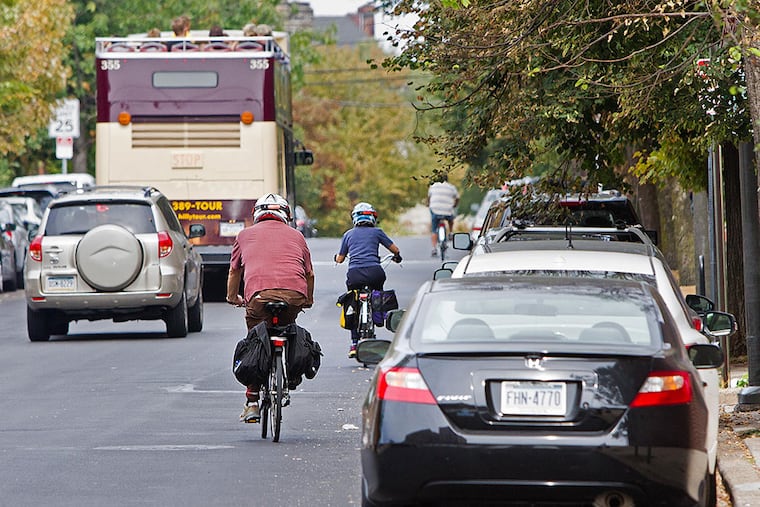Changing Skyline: Battling over bikes in Fairmount
Unlike so many of Philadelphia's polar-vortex-ravaged streets, the stretch of 22d between Spring Garden Street and Fairmount Avenue is as smooth and dark as a chocolate bar. It was repaved in August, and yet no white lines ruffle its silky surface. The way things are going, there won't be any for a long time.

Unlike so many of Philadelphia's polar-vortex-ravaged streets, the stretch of 22d between Spring Garden Street and Fairmount Avenue is as smooth and dark as a chocolate bar. It was repaved in August, and yet no white lines ruffle its silky surface. The way things are going, there won't be any for a long time.
Perhaps if the Streets Department had simply presented the roadwork as an effort to calm traffic, reduce crashes, and make the street safer for pedestrians, those stripes and glyphs would have been painted on long ago. Instead, the department's traffic engineers made the mistake of mentioning the B-word - as in bike lane - and now the worthy improvement project is ensnared in the web of City Council politics.
Leading the charge is Councilman William K. Greenlee, an at-large representative who lives in Fairmount. Although he says he's not anti-bike, he asserts that putting a bike lane on this part of 22d Street will slow automobile traffic and cause "serious backups."
His solution? Eliminate the bike lane, and devote it to cars.
Caught off-guard by his demand for more automobile capacity - most neighborhoods want less - the Streets Department has responded by delaying the striping until a consensus can be reached.
In the scheme of the city's entire bike network, this segment isn't particularly long, just seven blocks. But the stalemate has consequences that go beyond the Spring Garden neighborhood. Greenlee's action marks the first time a Council member has invoked the powers of a 2012 bill giving legislators final say over new segments of the bike network.
That bill was Greenlee's baby. If he can torpedo this small piece of the bike network, think what Council can accomplish collectively. Even though the neighborhood is part of Council President Darrell L. Clarke's district, he has yet to say where he stands.
All this is a real concern because Mayor Nutter - derided as "Mayor Bike Lane" by some Council members - isn't going to be in office much longer. Who knows whether his successor will continue to support his progressive, "complete streets" policies, which ensure that roads are designed to accommodate all users equitably - motorists, bicyclists, pedestrians.
For years, traffic engineering was all about satisfying the motorist. The goal was to move cars quickly and efficiently, even when doing so meant ravaging urban neighborhoods. But the profession has finally started to come around, and city streets are now being designed to give pedestrians and cyclists their fair share of territory.
Under Nutter, Philadelphia has been at the forefront of the approach, expanding the bike network and looking for ways to improve pedestrian conditions. As a result, urban cycling has exploded. Nearly 14,000 residents now commute by bike at least three days a week, up from 11,000 in 2006, according to city officials. Yet strangely, the more popular cycling becomes, the more it's demonized.
What opponents don't understand is that bike lanes can be a tool to make conditions better for all users. By clearly delineating space for cars and bikes, all players know their place. On Spruce and Pine Streets, which were turned into major bike corridors under Nutter, accidents have fallen by 30 percent, says Andrew Stober, who runs the Mayor's Office of Transportation and Utilities.
The explanation for the drop is simple. The two streets have been reduced to one car lane each, forcing motorists to drive more slowly. Cyclists feel safer, too, so they're less likely to ride on the sidewalk. That increases the chances that pedestrians will have the space all to themselves.
It was that kind of thinking that informed the redesign of 22d Street, according to Streets Commissioner David Perri. Because the stretch between Spring Garden and Fairmount is unusually wide for a residential street, many drivers, including Greenlee, assumed it was a two-lane road. They would reflexively step on the gas. When buses would stop for a passenger, they often tried to scoot around. Such behavior is incredibly dangerous for pedestrians.
Perri's solution was to put 22d Street on a "road diet," engineer-speak for traffic calming. The plan was to clearly stripe the stretch as one lane, then use the leftover space on the right-hand side for a bike lane.
Installing the lane also was meant to fill a significant gap in the bicycle network, because a bike lane already exists on 22d Street south of Spring Garden. As the only northbound bike lane on the west side of Center City, it's a major travel route. Building the missing link would have the added benefit of creating a dedicated route between the east-west bike corridors on Spring Garden and Fairmount Avenue.
Even though he's designated himself as neighborhood traffic planner, Greenlee doesn't seem to understand the theory behind the 22d Street traffic calming. "I don't know if I'm right or wrong, but that's the opinion I gave to the Streets Department."
He worries the striping plan also will cause havoc for the two bus lines - the 48 and 7 - that use the street. He forgets that they rarely encounter problems when they rumble south on 23d Street, which already is one lane in the Spring Garden neighborhood.
Perri does have a way out of the mess. He suggests a trial run using traffic cones to mark the dividing line between cars and bikes. A public meeting would also help educate residents about the plan.
Until then, Greenlee's objections leave the neighborhood in limbo. With no markings, 22d Street will remain a free-for-all until further notice. Pedestrians and cyclists, beware.
215-854-2213 @ingasaffron